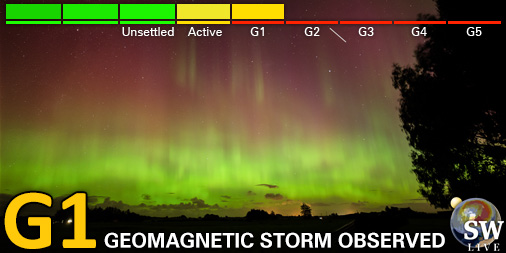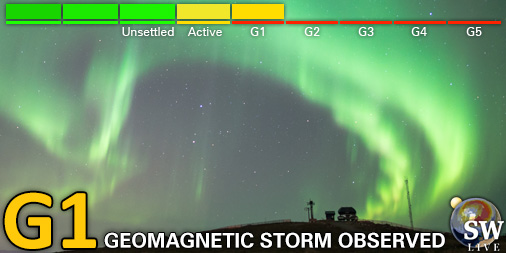Het archief bekijken van donderdag 1 augustus 2024
Dagelijks bulletin over zonne- en geomagnetische activiteit van het SIDC
Datum verslag: 2024 Aug 01 1231 UTC
SIDC Prognose
Zonnevlammen
M-class flares expected (probability >=50%)
Geomagnetisme
Minor storm expected (A>=30 or K=5)
Proton Flux monitor
Warning condition (activity levels expected to increase, but no numeric forecast given)
| 10cm flux | Ap | |
|---|---|---|
| 01 Aug 2024 | 239 | 024 |
| 02 Aug 2024 | 242 | 014 |
| 03 Aug 2024 | 240 | 010 |
Zonnevlekkengebieden en zonnevlammen
Solar flaring activity over the last 24 hours has been at high levels, with fourteen M-class flares, four of which above M5. The strongest flares were an M8.2 flare peaking at 07:09 UTC on August 01, associated with NOAA AR 3768 (beta-gamma-delta) and an M6.3 flare peaking at 01:50 UTC on August 01, associated with NOAA AR 3773 (beta). There are currently thirteen numbered active regions on the solar disk. The most complex ones are NOAA ARs 3765 and 3768 (both beta-gamma- delta). NOAA AR 3767 has evolved to magnetic type beta-delta. NOAA AR 3775 (beta) has rotated on disk from the east limb, in the northeast quadrant. A new, currently unnumbered active region has emerged south of NOAA AR 3775. NOAA AR 3762, 3768 and 3771 are currently rotating behind the west limb. The solar flaring activity is expected to be at moderate to high levels over the next 24 hours, with M-class flares expected and a chance for X-class flares.
Coronale massa uitstoten
A partial halo CME was observed in LASCO/C2 coronagraph imagery around 18:48 UTC on July 31, lifting off the west limb. It is likely associated with an M5.3 flare peaking at 18:37, from NOAA AR 3768. A related type II radio emission was observed, starting at 18:20 UTC on July 31 with an estimated velocity of 326 km/s. An associated type IV radio emission was observed, starting at 18:31 UTC on July 31. Due to the estimated location of the CME source region, a mild glancing blow may arrive at Earth late on August 04. A partial halo CME was observed in LASCO/C2 coronagraph imagery around 06:40 UTC on August 01, lifting off the west limb. It is most likely associated with an M8.2 flare from NOAA AR 3768, starting at 06:20 UTC and peaking at 07:09 UTC on August 01. An associated type II radio emission was observed, starting at 07:12 UTC on August 01 with an estimated velocity of 739 km/s. A related type IV radio emission was observed, starting at 07:08 UTC on August 01. Further analysis for potential Earth-directed components is ongoing. No other Earth-directed CMEs were observed in the available coronagraph imagery.
Zonnewind
Solar wind conditions were slightly enhanced during the last 24 hours, most likely due to the combined arrival of two of the expected coronal mass ejections (CMEs) from July 28-29. Speed values reached a maximum of 490 km/s and the interplanetary magnetic field a maximum of 16 nT, with a possible shock observed around 13:47 UTC on July 31, but marked with a very low density in the preceding period. The Bz component varied between -13 nT and 12 nT. The interplanetary magnetic field angle was mostly positive, with negative intervals around 14:40 to 16:00 UTC and 17:50 to 22:30 UTC on July 31. Further enhancements in the solar wind conditions may be expected over the next 24 hours due to the predicted arrival of a partial halo CME (observed at 02:40 UTC on July 29) and a possible glancing blow from another CME (obesrved at 13:36 UTC on July 29).
Geomagnetisme
Geomagnetic conditions globally reached minor storm levels (NOAA Kp 5 or 5-) between 18:00-21:00 UTC on July 31 and between 00:00-06:00 UTC on August 01. Geomagnetic conditions locally reached active levels (K BEL 4) between 16:00-22:00 UTC on July 31 and 01:00-04:00 UTC on August 01. Geomagnetic conditions globally are currently at active levels (NOAA Kp 4-) and at unsettled levels locally (K BEL 3). Quiet to active levels, with possible minor storm conditions (NOAA Kp 2 to 5) are expected globally and locally over the next 24 hours due to the predicted arrival of a coronal mass ejection (CME) and a possible glancing blow.
Proton flux niveaus
The greater than 10 MeV proton flux was below the threshold level over the past 24 hours. It is expected to remain below the threshold level over the next 24 hours, pending new eruptive activity from the active regions near the west limb and the active regions clustered around NOAA AR 3766.
Elektronenfluxen in geostationaire baan
The greater than 2 MeV electron flux was below the threshold level in the last 24 hours and is expected to remain so over the next 24 hours. The 24h electron fluence is presently at normal levels and is expected to remain so over the next 24 hours.
Het geschatte internationale zonnevlekkengetal (ISN) van vandaag: 258, gebaseerd op 14 stations.Zon indexen voor 31 Jul 2024
| Wolfgetal Catania | /// |
| 10cm zonneflux | 235 |
| AK Chambon La Forêt | 036 |
| AK Wingst | 020 |
| Geschatte Ap | 018 |
| Geschat internationaal zonnevlekkengetal | 270 - Gebaseerd op 33 stations |
Overzicht opvallende gebeurtenissen
| Dag | Start | Max | Einde | Locatie | Sterkte | OP | 10cm | Catania/NOAA | Soorten radio-uitbarstingen |
|---|---|---|---|---|---|---|---|---|---|
| 31 | 1245 | 1305 | 1326 | S22E55 | M6.0 | 1N | --/3772 | III/2 | |
| 31 | 1326 | 1332 | 1337 | S22E55 | M4.4 | 1N | --/3774 | ||
| 31 | 1610 | 1631 | 1641 | S15W68 | M1.4 | SF | --/3774 | ||
| 31 | 1805 | 1837 | 1858 | S15W71 | M5.3 | SF | 37/3768 | II/2III/2IV/2 | |
| 31 | 2136 | 2155 | 2210 | S15W71 | M1.2 | SF | 35/3767 | III/2 | |
| 31 | 2242 | 2250 | 2259 | ---- | M1.0 | --/3774 | |||
| 01 | 0050 | 0058 | 0103 | ---- | M1.2 | --/3770 | III/1 | ||
| 01 | 0147 | 0150 | 0154 | ---- | M6.3 | --/3773 | V/3 | ||
| 01 | 0258 | 0306 | 0314 | ---- | M1.2 | --/3774 | |||
| 01 | 0359 | 0409 | 0423 | ---- | M1.9 | --/3774 | |||
| 01 | 0435 | 0441 | 0445 | ---- | M4.0 | 35/3765 | III/2 | ||
| 01 | 0552 | 0556 | 0600 | S12W35 | M1.5 | SF | 37/3768 | III/2 | |
| 01 | 0623 | 0709 | 0739 | S16W74 | M8.2 | 1N | 37/3768 | III/2IV/2II/2 | |
| 31 | 1807 | 1837 | 1857 | S15W71 | M5.4 | SF | 37/3768 | II/2III/2IV/2 |
Aangeboden door het Solar Influences Data Analysis Center© - SIDC - Verwerkt door SpaceWeatherLive
Alle tijden in UTC
<< Keer terug naar de dagelijkse overview pagina
Op basis van de huidige parameters is er in de nabije toekomst een beperkte kans op poollicht op de volgende locaties van de hoge breedtegraad
Gillam, MB, Iqaluit, NUNuuk
Laatste nieuws
Laatste forumberichten
Steun Poollicht.be!
Om ook bereikbaar te blijven bij grote poollichtkansen hebben we een zware server nodig die alle bezoekers aankan. Doneer en steun dit project zodat we online blijven en je geen enkele poollichtkans mist!

Laatste alerts
zondag 6 april 2025
02:00 UTC - Geomagnetische activiteit
G1 - Kleine geomagnetische storm (Kp5) Drempel bereikt: 01:50 UTC
zaterdag 5 april 2025
20:30 UTC - Geomagnetische activiteit
G1 - Kleine geomagnetische storm (Kp5) Drempel bereikt: 20:20 UTC
20:24 UTC - Zonnevlam
Matige M1.05 zonnevlam
20:09 UTC - Radio blackout
Kleine R1 radio blackout gedetecteerd (≥M1 - momenteel: M1.05)
10:00 UTC - Hemisferisch vermogen
Het OVATION-model voorspelt dat het hemisferisch vermogen 78GW zal bereiken om 10:32 UTC
Ruimteweer feitjes
| Laatste X-klasse uitbarsting | 28/03/2025 | X1.1 |
| Laatste M-klasse uitbarsting | 05/04/2025 | M1.0 |
| Laatste geomagnetische storm | 06/04/2025 | Kp5 (G1) |
| Zonnevlekkenloze dagen | |
|---|---|
| Laatste zonnevlekkenloze dag | 08/06/2022 |
| Maandelijks gemiddeld zonnevlekkengetal | |
|---|---|
| maart 2025 | 134.2 -20.4 |
| april 2025 | 150.4 +16.2 |
| Afgelopen 30 dagen | 132.4 -10.1 |





